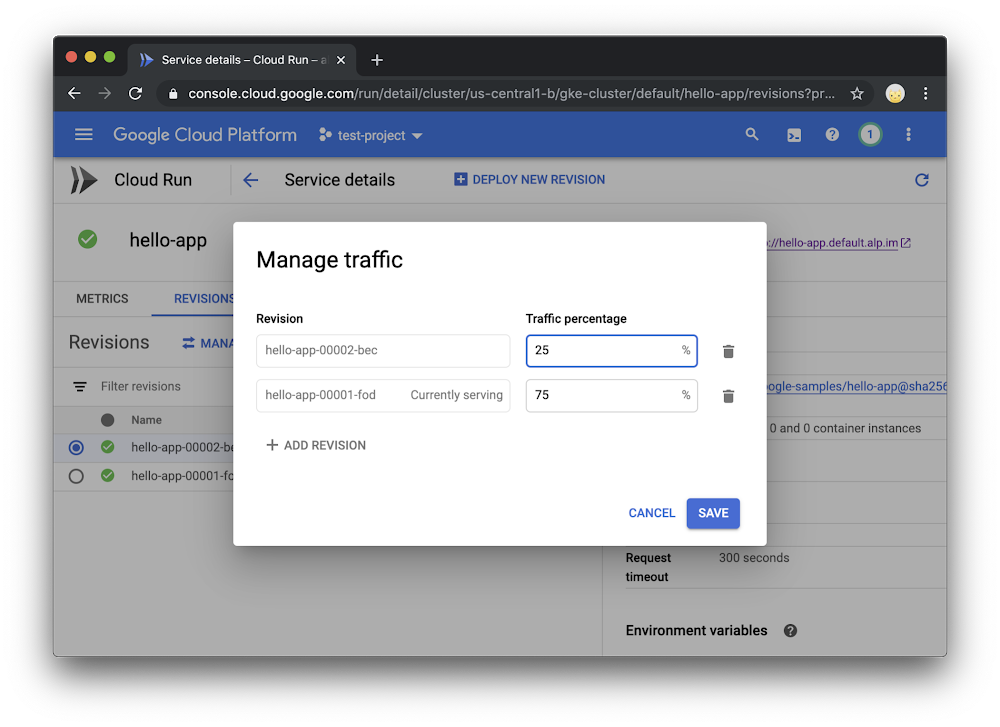Earlier this year, we announced Cloud Run, our newest compute platform for serverless containers, which runs either on Google’s fully managed infrastructure–or on your Google Kubernetes Engine (GKE) clusters with Cloud Run for Anthos. This portability is achieved with Knative open-source APIs.With Cloud Run for Anthos, we deliver and manage everything you need to support serverless containers on your GKE clusters, for example Knative and a service mesh, and it’s now generally available. Let’s take a look at some of the new features and improvements, including better networking and autoscaling capabilities, that make it easier to deploy and operate microservices in a serverless way on your Anthos GKE clusters. (Also make sure to check out what’s new in Cloud Run fully managed.) Traffic managementCloud Run for Anthos can now route each request or RPC randomly between multiple revisions of a service with the traffic percentages you configure. You can use this feature to perform canary deployments of a newer version of your application, sending a small percentage of the traffic and validating if it is performing correctly, before gradually increasing the traffic.Similarly, these new traffic management capabilities make it possible to roll back to an older version of your application quickly. You can manage traffic to your service on the Cloud Console, as well as the gcloud command-line tool.Bringing Cloud Run to your on-prem clustersThe beta of Cloud Run for Anthos only supported GKE clusters running on Google Cloud Platform (GCP). With the general availability of Cloud Run for Anthos, you can now deploy Cloud Run to your on-premises clusters deployed on VMware.With this, you can have the same serverless developer and operator experience across both environments. You can use either gcloud or the Cloud Console to deploy to your Anthos clusters and monitor them, regardless of whether they are running on-prem, or on GCP.Support for Kubernetes Secrets and ConfigMapsYou can now mount existing Kubernetes Secret and ConfigMap resources in your cluster to Cloud Run services using the Cloud Console interface or gcloud. This lets you deploy services without crafting lengthy Kubernetes manifest files.Fine tune network and autoscaling parametersWith the new improvements in the Cloud Console and gcloud, you can now further tune the autoscaling and networking parameters of your application at per-revision level.–min-instances / –max-instances let you specify the scaling boundaries of your application. For example, setting –min-instances to greater than 0 prevents your service from scaling down to zero in case of inactivity to prevent cold starts.–timeout allows you to specify a custom request timeout for your service.–port allows you to customize and specify on which port number your containerized application is listening. This allows you to bring your apps to Cloud Run without having to modify the application server’s port number.Some of these options are currently in beta, however soon these and many other configuration options will be available to you in the command-line and the Cloud Console.Making your services more observableOut of the box, Cloud Run for Anthos integrates with Stackdriver Monitoring to expose metrics from the services you have deployed. With general availability, you can find these metrics on Stackdriver Metrics, or directly on the “Metrics” tab of the service’s Cloud Run page.These metrics include some golden signals: request latencies, error rates, CPU and memory usage, and container instance count. You can further use these metrics to drill down by revision of your application, and create alerts and SLOs using Stackdriver Monitoring.It’s also worth noting that you get the same set of metrics even if your Anthos cluster is running on-premises, for example on VMware.Smaller cluster footprintThe Istio add-on is now optional for Cloud Run for Anthos, as Cloud Run now includes select components of Istio. The full version of Istio is still a great complement to Cloud Run if you want to have cluster-wide traffic policies and use Anthos Service Mesh dashboard to have single pane of glass visibility to services in your cluster. The Istio community has recently made several improvements to Istio, including reductions in its resource footprint.Partner ecosystemWe’re working with a wide variety of ISVs in the areas of CI/CD, security and observability so that you can continue to use your favorite tools with applications running on Cloud Run for Anthos. Click here for a recent list of Cloud Run partners and integrations. Try it today!Both Cloud Run fully managed and Cloud Run for Anthos are available for you to try out for your applications today. You can try out Cloud Run on your Anthos GKE clusters by following the quickstart guide for free until May 2020. You can also use the 12-month GCP free trial to get $300 in credit and create a cluster with Cloud Run for Anthos. And if you’re already running Anthos on-premises, try this quickstart guide to deploy Cloud Run to your VMware environment.
Quelle: Google Cloud Platform

Published by